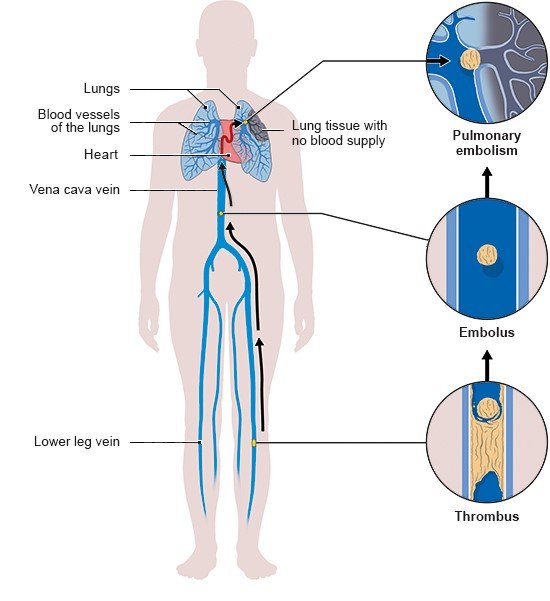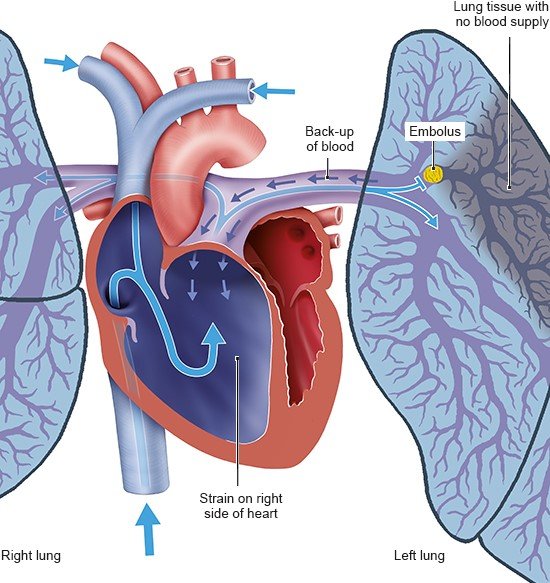Arbjerg Højen A, Dreyer PS, Lane DA et al. Adolescents' and Young Adults' Lived Experiences Following Venous Thromboembolism: "It will always lie in wait". Nurs Res 2016; 65(6): 455-464.
Crawford F, Andras A, Welch K et al. D-dimer test for excluding the diagnosis of pulmonary embolism. Cochrane Database Syst Rev 2016; (8): CD010864.
Deutsche Gesellschaft für Angiologie – Gesellschaft für Gefäßmedizin (DGA). Diagnostik und Therapie der Venenthrombose und der Lungenembolie (S2k-Leitlinie). AWMF-Registernr.: 065-002. 2015.
Duffett L, Castellucci LA, Forgie MA. Pulmonary embolism: update on management and controversies. BMJ 2020; 370: m2177.
Hao Q, Dong BR, Yue J et al. Thrombolytic therapy for pulmonary embolism. Cochrane Database Syst Rev 2018; (12): CD004437.
Izcovich A, Criniti JM, Popoff F et al. Thrombolytics for venous thromboembolic events: a systematic review with meta-analysis. Blood Advances 2020; 4(7): 1539-1553.
Khatib R, Ross S, Kennedy SA et al. Home vs hospital treatment of low-risk venous thromboembolism: a systematic review and meta-analysis. Blood Adv 2020; 4(3): 500-513.
Kirchberger I, Ruile S, Linseisen J et al. The lived experience with pulmonary embolism: A qualitative study using focus groups. Respir Med 2020; 167: 105978.
Konstantinides SV, Meyer G, Becattini C et al. 2019 ESC Guidelines for the diagnosis and management of acute pulmonary embolism developed in collaboration with the European Respiratory Society (ERS). Eur Heart J 2020; 41(4): 543-603.
Maughan BC, Frueh L, McDonagh MS et al. Outpatient Treatment of Low-risk Pulmonary Embolism in the Era of Direct Oral Anticoagulants: A Systematic Review. Acad Emerg Med 2021; 28(2): 226-239.
Noble S, Lewis R, Whithers J et al. Long-term psychological consequences of symptomatic pulmonary embolism: a qualitative study. BMJ Open 2014; 4(4): e004561.
Ortel TL, Neumann I, Ageno W et al. American Society of Hematology 2020 guidelines for management of venous thromboembolism: treatment of deep vein thrombosis and pulmonary embolism. Blood Adv 2020; 4(19): 4693-4738.
Pöss J, Freund A, Vollert JO et al. Lungenarterienembolie. Prozessorientierte und standardisierte Umsetzung der nationalen und internationalen Leitlinien. Kardiologe 2018; 12: 68–82.
Pschyrembel Online. 2022.
Robertson L, Kesteven P, McCaslin JE. Oral direct thrombin inhibitors or oral factor Xa inhibitors for the treatment of pulmonary embolism. Cochrane Database Syst Rev 2015; (12): CD010957.
Rolving N, Brocki BC, Andreasen J. Coping with everyday life and physical activity in the aftermath of an acute pulmonary embolism: A qualitative study exploring patients' perceptions and coping strategies. Thromb Res 2019; 182: 185-191.
Yoo HH, Nunes-Nogueira VS, Fortes Villas Boas PJ et al. Outpatient versus inpatient treatment for acute pulmonary embolism. Cochrane Database Syst Rev 2019; (3): CD010019.
Young T, Sriram KB. Vena caval filters for the prevention of pulmonary embolism. Cochrane Database Syst Rev 2020; (10): CD006212.
IQWiG health information is written with the aim of helping people understand the advantages and disadvantages of the main treatment options and health care services.
Because IQWiG is a German institute, some of the information provided here is specific to the German health care system. The suitability of any of the described options in an individual case can be determined by talking to a doctor. informedhealth.org can provide support for talks with doctors and other medical professionals, but cannot replace them. We do not offer individual consultations.
Our information is based on the results of good-quality studies. It is written by a team of health care professionals, scientists and editors, and reviewed by external experts. You can find a detailed description of how our health information is produced and updated in our methods.



